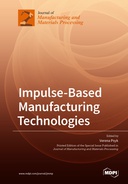Explore

Impulse-Based Manufacturing Technologies
Verena Psyk (editor)
2022
0 Ungluers have
Faved this Work
Login to Fave
In impulse-based manufacturing technologies, the energy required to form, join or cut components acts on the workpiece in a very short time and suddenly accelerates workpiece areas to very high velocities. The correspondingly high strain rates, together with inertia effects, affect the behavior of many materials, resulting in technological benefits such as improved formability, reduced localizing and springback, extended possibilities to produce high-quality multi material joints and burr-free cutting. This Special Issue of JMMP presents the current research findings, which focus on exploiting the full potential of these processes by providing a deeper understanding of the technology and the material behavior and detailed knowledge about the sophisticated process and equipment design. The range of processes that are considered covers electromagnetic forming, electrohydraulic forming, adiabatic cutting, forming by vaporizing foil actuators and other impulse-based manufacturing technologies. Papers show significant improvements in the aforementioned processes with regard to: Processes analysis; Measurement technique; Technology development; Materials and modelling; Tools and equipment; Industrial implementation.
This book is included in DOAB.
Why read this book? Have your say.
You must be logged in to comment.
Rights Information
Are you the author or publisher of this work? If so, you can claim it as yours by registering as an Unglue.it rights holder.Downloads
This work has been downloaded 97 times via unglue.it ebook links.
- 97 - pdf (CC BY) at Unglue.it.
Keywords
- 18Ni300 maraging steel
- 22MnB5
- AA6016
- additive manufacturing
- adiabatic blanking
- adiabatic shear band
- Aluminum
- aluminum and copper
- automotive alloys
- blanked surface
- bulge forming
- Clearance
- cloud of particles
- coil windings
- collision velocity
- collision welding
- conductivity
- constitutive modelling
- damage modelling
- dissimilar material combinations
- electro-hydraulic
- electro-hydraulic forming
- electromagnetic forming
- elevated temperature
- energy balance
- energy extraction
- FE simulation
- formability
- high pulsed power
- high strain rate
- high strain rates
- high velocity
- high-speed imaging
- History of engineering & technology
- impact angle
- impact deformation
- impact velocity
- impact welding
- impulse forming
- inclined collision welding
- interface characterization
- interface morphology
- jet
- lightweight
- linear coils
- Lorentz forces
- LS-DYNA
- machining simulation
- magnetic pulse forming
- magnetic pulse welding
- magnetic pulse welding (MPW)
- material properties
- mechanical characterization
- melting
- n/a
- Numerical analysis
- Numerical Simulation
- Permeability
- powder compaction
- Preforming
- press-hardening steel
- proximity effect
- pulsed forming
- shear lap test
- simulation
- spallation
- spot welds
- stress triaxiality
- Technology, engineering, agriculture
- Technology: general issues
- tribological characterization
- vaporizing foil actuator
- welding window
Links
DOI: 10.3390/books978-3-0365-2891-5Editions

